Last Updated on February 10, 2024 by Aftab Tariq
Giant Alaskan Malamute is a remarkable breed hailing from Alaska and boasts a rich history linked to the Arctic and the native Mahlemuts. These dogs sport striking colors like black, gray, and white, ideal for cold climates.
My friend, Bushra, used to have a fondness for giant malamutes because of their large size and impressive fur when she was younger. However, as she learned from breeders who genuinely prioritize the well-being of the dogs, her enthusiasm for giants gradually diminished.
Bushra now appreciates the importance of responsible breeding practices and the welfare of animals, opting for a more informed and compassionate approach to her interests.
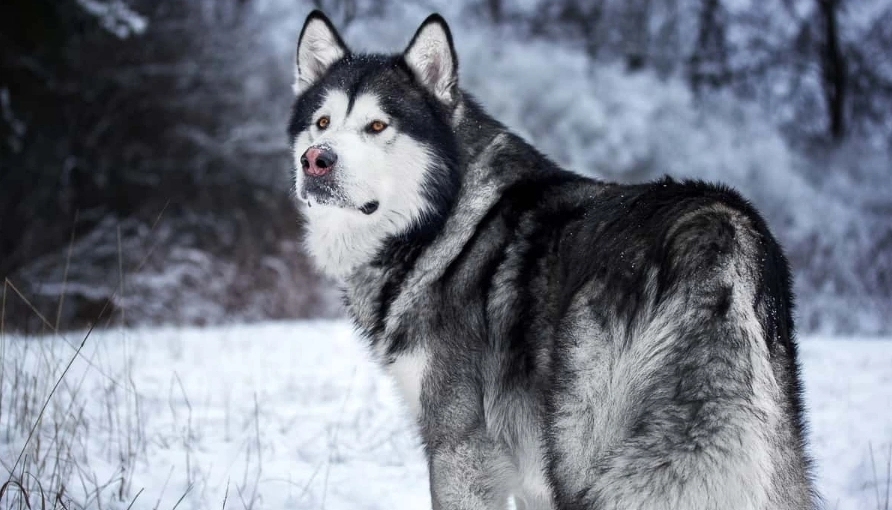
Source: Pinterest
They excel in transportation tasks, often pulling sledges over great distances due to their robust strength and endurance. With a friendly temperament and unwavering loyalty, they make perfect companions for outdoor activities and thrilling adventures.
Responsible breeders and sound breeding practices ensure their well-being and health. Rescue shelters offer loving homes to those in need. Giant Alaskan Malamutes embody Alaska’s legacy and the Arctic’s heritage. Their story blends history and the splendor of nature’s shades through their coat colors. Roger Caras said:
“Dogs are not our whole life, but they make our lives whole”
Overview of Giant Alaskan Malamute

An Alaskan Malamute Overview provides insight into the world of this breed. Alaskan Malamutes are known for their remarkable strength and endurance, making them excellent for activities like sledging, skijoring, and backpacking.
Their boundless energy and enthusiasm make them great exercise companions for everyone, though they can only be a handful with sufficient exercise opportunities. Their size and markings set them apart, often misconceived as wolves.
While their independence and intelligence can lead to restlessness, they are incredibly loyal companions, and their vocalizations can serve as effective watchdogs.
Be prepared for stubbornness in training and occasional efforts to dig holes and raid kitchen counters for treats or trash. These dogs have played crucial wolf roles, assisting in hunting and sledge pulling, and have adapted to harsh Arctic environments. Despite their imposing size, they are gentle friends to have around.
| Characteristic | Details |
| Origin | Alaska, United States |
| Size | Large breed, males: 25 inches tall at the shoulder and 85 pounds, females: 23 inches tall and 75 pounds |
| Breed Group | Working dog |
| Giant Alaskan Malamute Lifespan | 10-14 years |
| Coat | The thick, double coat that comes in gray, black, white, and sable |
| Giant Alaskan Malamute Temperament | Gentle giants are loyal, affectionate, and playful but can be independent and stubborn. |
| Exercise Needs | High, at least 2 hours of exercise per day |
| Training | Needs early and consistent training, can be stubborn |
| Grooming | Moderate, requires brushing 2-3 times per week |
| Health | Some health concerns include hip dysplasia, elbow dysplasia, eye problems, and bloat. |
History of Alaskan Malamute

They have deep roots with indigenous peoples, like the Mahlemuts and Kotzebues, who influenced their lineage. Maintaining the breed’s purity was vital for their strength in expeditions, seal hunting, and even as polar bear deterrents.
It was in 1935 when the Alaskan Malamute Club of America was established, and they gained recognition from the AKC that same year. During World War II, they served differently by helping transport supplies.
Their lineage faced challenges from interbreeding, but dedicated breeding efforts kept their unique characteristics intact. The Alaskan Malamute remains a symbol of endurance and survival, with a remarkable history connected to the people and climate of Alaska and Siberia. Their story is one of resilience and service to those who relied on them.
What does ‘Giant’ malamute mean?
There is no existence of a ‘giant’ malamute. All malamutes share a common ancestry. To increase their size, certain breeders choose parents solely based on size, overlooking crucial factors like health and temperament.
As a result of this practice over multiple generations, the dogs become larger but undergo changes in appearance and experience a decline in overall health. These larger puppies often command higher prices due to the perception of rarity.
Giant Alaskan Malamute Size

The size of Alaskan Malamutes can vary significantly. Typically, these impressive dogs can stand between 23 and 25 inches in shoulder height and weigh anywhere from 75 to 85 pounds for females and 85 to 100 pounds for males in their adult stage.
The Personality of Alaskan Malamutes
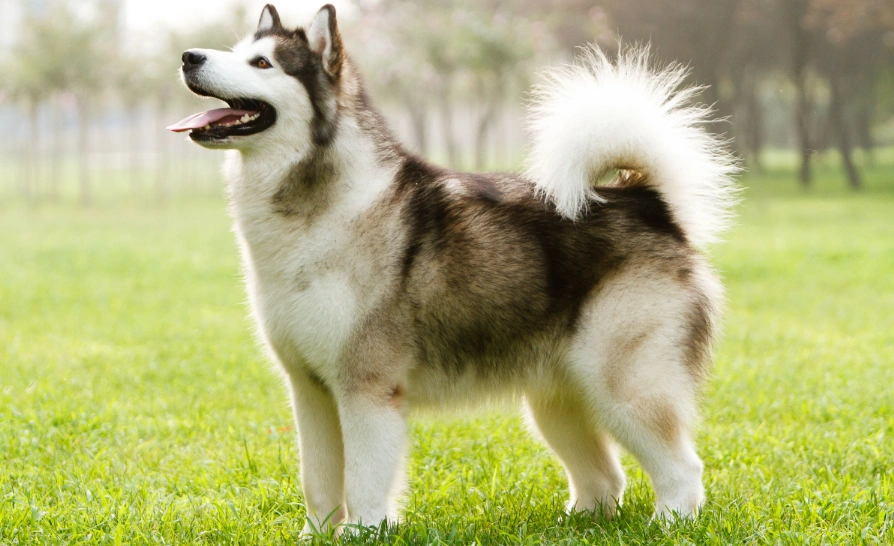
Source: Pinterest
The personality of Giant Alaskan Malamutes is as distinctive as their name. Giant Alaskan Malamutes exhibit a unique blend of traits shaped by their genetics, experiences, and socialization. From the very beginning, these dogs showcase a curiosity and playfulness that warms the hearts of their family.
Their loyalty to the human pack is unwavering, making Giant Alaskan Malamutes excellent watchdogs and loving companions for family activities and park strolls.
Socialization plays a vital role in the development of Giant Alaskan Malamutes as they learn to interact with family, friends, and even strangers. Puppy kindergarten classes and visits to stores and neighbors help build their social skills and ensure they grow into well-rounded individuals.
Their temperament is a blend of natural dispositions and training, balancing their howl-filled “woo” greetings and their ability to be calm and attentive when needed.
Giant Alaskan Malamutes are known for their friendly behavior with everyone, including relatives and visitors, making them a beloved part of the family. Adopting one of these wonderful Giant Alaskan Malamute puppies is not just a choice of a pet but an addition of a loyal and loving member to your family.
Key Points About Alaskan Malamutes
Not Ideal for First-Time Owners: Alaskan Malamutes, known for their intelligence, can be a handful for novice dog owners. Their stubbornness and training challenges may be overwhelming for those needing more experience or patience.
Establish Leadership: As pack animals, Alaskan Malamutes need a clear leader in the household. It’s essential to establish yourself as the alpha and maintain consistent training to prevent them from taking charge.
Thick Coats, Climate Consideration: These dogs boast majestic, thick double coats that provide warmth in cold weather. However, this can lead to overheating in hot climates. Owners in warm regions must ensure shade and abundant water to keep them cool.
Exercise and Stimulation: Alaskan Malamutes are intelligent and active, requiring mental and physical stimulation. Neglecting these needs may result in destructive behavior due to boredom.
High Prey Drive: They have a strong instinct to chase and hunt small animals, so introducing them to other pets must be done gradually and cautiously.
Seasonal Heavy Shedding: Be prepared for their heavy shedding, which occurs twice a year. Regular brushing is essential during these periods to manage loose hair.
Vocalization Habits: While not frequent barkers, Alaskan Malamutes may howl or use vocalizations to communicate with their owners.
Consider Adoption: Many Alaskan Malamutes are available in shelters and rescues, offering an affordable and loving alternative to breeder-purchased dogs. Adopting from these organizations provides a second chance for these dogs to find a happy home.
Alaskan Malamute Coat Color and Grooming

Source: Pinterest
Alaskan Malamutes sport a dense double coat that demands regular grooming. Their outer coat is thick and coarse, while the undercoat is soft and woolly. Malamutes undergo heavy shedding twice yearly, necessitating consistent brushing to manage loose hair. Here are some grooming tips for Alaskan Malamutes:
- Brush your Malamute one to three times weekly using a slicker brush or undercoat rake to maintain a clean coat and distribute skin oils.
- During shedding seasons, increase brushing frequency to control hair loss.
- Bathe your Malamute only when necessary to prevent skin dryness.
- It is important to remove tartar and prevent gum disease by brushing your Malamute’s teeth at least twice or thrice weekly.
- Trim your Malamute’s nails once or twice a month to prevent overgrowth and discomfort.
- Conduct a weekly check of your Malamute’s ears for signs of redness or odor, which could indicate an infection.
- If you lack experience in nail trimming or ear cleaning, consult a veterinarian or groomer for assistance.
- Initiate grooming routines with your Giant Alaskan Malamute puppy to help them acclimate to the process. Make grooming a positive experience by offering treats and praise.
Care for Alaskan Malamutes

Source: Pinterest
Dog sledging and long walks are excellent activities for them. Paying attention to their coat health is vital, as their thick fur demands frequent grooming to prevent matting and maintain proper temperature regulation in various climates.
Their work ethic and ability to pull sledges make obedience training essential. Providing puzzle toys and other forms of stimulation can alleviate any potential boredom. Routine ear cleaning and vigilance for signs of ear infections are crucial for their hygiene.
Keeping their nails trimmed helps prevent issues related to their weight distribution. Alaskan Malamutes may have a strong prey drive, so supervision during outdoor adventures is essential. Shedding is a regular occurrence, which calls for diligent vacuuming, while their eye on your attention ensures a bond like no other.
Proper nutrition and regular vet visits support their overall well-being. With the right care and understanding, these Malamutes can thrive in your yard and become beloved family members.
Feeding an Alaskan Malamute
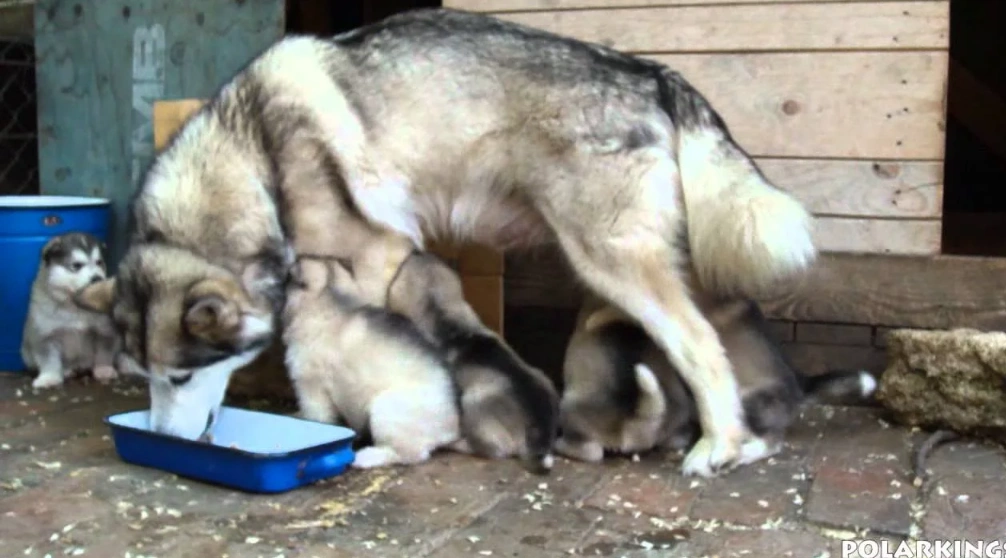
Source: Pinterest
Feeding an Alaskan malamute requires a well-considered feeding plan to cater to their specific diet and energy requirements at various stages of life, from puppyhood to adulthood. Understanding their size and energetic demands, as well as consulting a nutritionist or veterinarian, is crucial.
These professionals can guide you in determining the appropriate portion sizes and nutritional content to support your well-being and ensure your dietary needs are met. Feeding an Alaskan malamute is not just about providing sustenance; it’s about nourishing their body and mind to keep them healthy and happy.
Mixed-pet Families With Alaskan Malamute Dogs
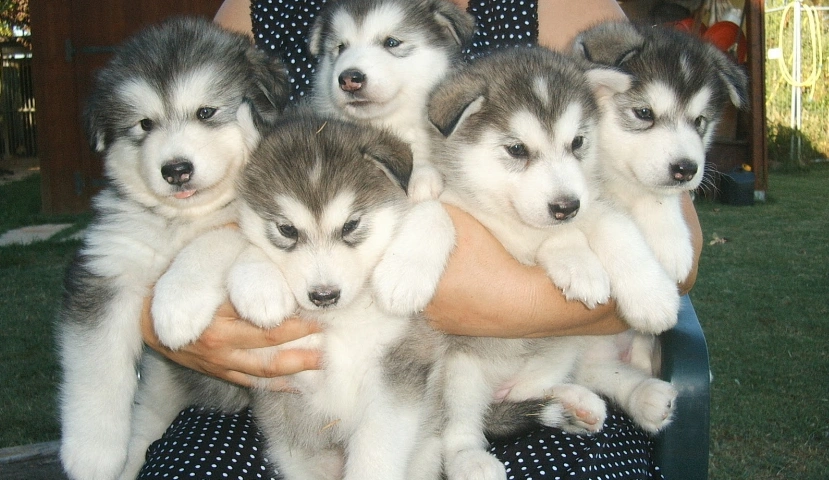
Source: Pinterest
In mixed-pet families with Alaskan malamute dogs, creating harmonious interactions among the dogs, cats, and children is a process that demands patience, supervision, and a thoughtful approach.
With five Malamutes and various household animals, attention to their age and individual temperaments is crucial. Socialization is key, ensuring that they understand how to approach each other with affection and respect.
Proper training and teaching appropriate touch techniques can prevent unwanted behaviors like biting, ear or tail pulling, and food conflicts. Consistent interactions should be guided to create a safe and loving environment where children can enjoy the companionship of dogs and cats while fostering a strong bond among all the animals in the family.
Organizations Saving Alaska’s Malamutes

Source: Pinterest
Organizations saving Alaska’s Malamutes play a vital role in the well-being of these magnificent Malamutes. They provide a lifeline for these gentle giants needing adoption or rescue in the area, offering them a chance at a loving home.
The commitment of a breed club, both at the national and local levels, is essential for the fostering of understanding about the breed and the specific needs of Alaskan Malamutes. These rescues act as a bridge between these dogs and their forever homes, ensuring that every Malamute gets the care and attention they deserve.
The dedication of these organizations is truly commendable, as they work tirelessly to save, protect, and find loving homes for these incredible dogs.
Breed Clubs for Giant Alaskan Malamute
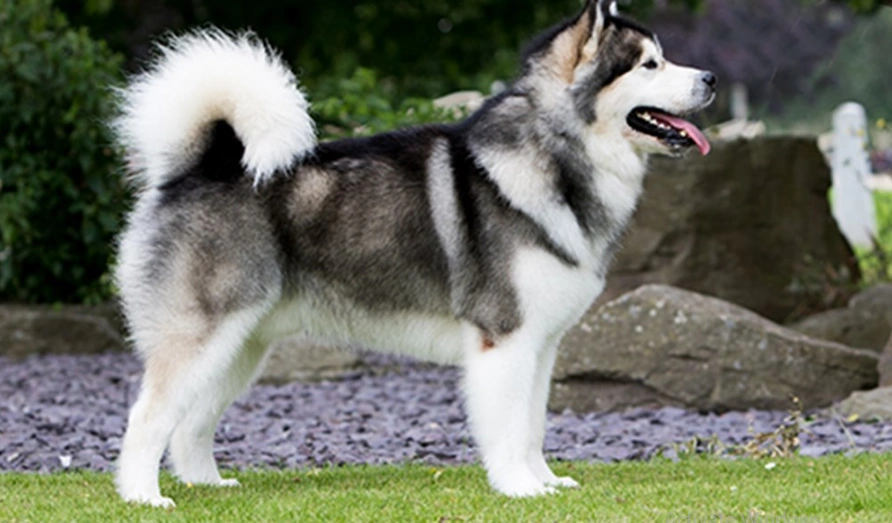
Source: Pinterest
Breed clubs for Alaskan Malamutes are instrumental in guiding responsible breeders and breeding stock to ensure the health and well-being of these majestic dogs throughout their lifetime. These organizations play a crucial role in setting standards and educating breeders about the importance of ethical decisions in their breeding programs.
By offering lifetime support and encouraging a focus on the health of the dogs rather than profit, these breed clubs work to eliminate health problems resulting from irresponsible breeding practices.
In contrast to backyard breeders, the breed clubs emphasize the welfare of Alaskan Malamutes, striving to produce healthy, loving companions rather than puppies as a mere result.
They are committed to the betterment of the breed, ensuring that Alaskan Malamutes lead happy and healthy lives, free from genetic issues and unnecessary health problems. The Giant Alaskan Malamute white in color, stands proud and magnificent, catching the eye with its impressive presence.
Giant Alaskan Malamute Health
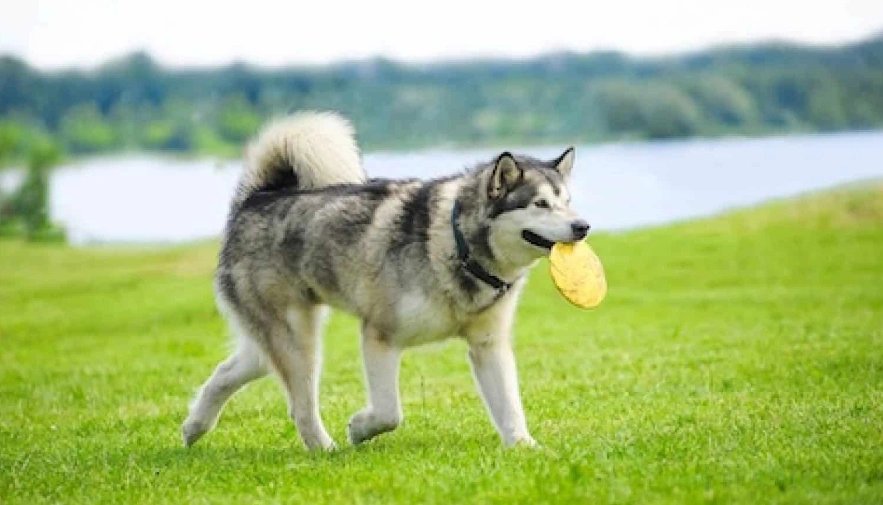
Source: Pinterest
While generally robust, Alaskan Malamutes are predisposed to certain health conditions. Common issues in Alaskan Malamutes encompass:
Cataracts: This eye condition involves lens clouding, potentially leading to blindness. Juvenile cataracts, often appearing between 1 and 2 years of age, are particularly relevant to Malamutes.
Chondrodysplasia: A genetic disorder causing dwarfism, resulting in short or bowed legs and skeletal deformities in affected Malamutes.
Hypothyroidism: A condition arising from an underactive thyroid gland, leading to symptoms such as a dry coat, weight gain, and hair loss in Malamutes.
Hip Dysplasia: This hereditary ailment occurs when the thighbone does not sit flush within the hip joint; the individual may experience discomfort, lameness, and even arthritis.
Hemeralopia (Day Blindness): Malamutes with this condition exhibit heightened sensitivity to light, potentially causing difficulties in bright sunlight.
Polyneuropathy: Suggested for testing by the Canine Health Center, this genetic disorder impacts the canine nervous system.
Note: In the grand tapestry of canine tales, the Giant Alaskan Malamute weaves a unique story of strength, loyalty, and enchantment, leaving an indelible mark on every reader’s heart. Giant Alaskan Malamute puppies for sale offer bundles of joy and companionship for loving homes.
Frequently Asked Question
What is the Largest Alaskan Malamute?
The giant Alaskan Malamute height varies among individuals, but males typically reach around 25 inches and weigh between 85 to 100 pounds, while females are slightly smaller, reaching heights of around 23 inches and weighing between 75 to 85 pounds.
Is there a Difference Between a Giant Alaskan Malamute and an Alaskan Malamute?
Sources
Belgium’s Alaskan Malamute Club
I am a dedicated content writer with more than five years of experience, particularly skilled in the art of storytelling. My writing journey commenced during my college years, where I pursued journalism and unearthed my talent for creating captivating narratives.


